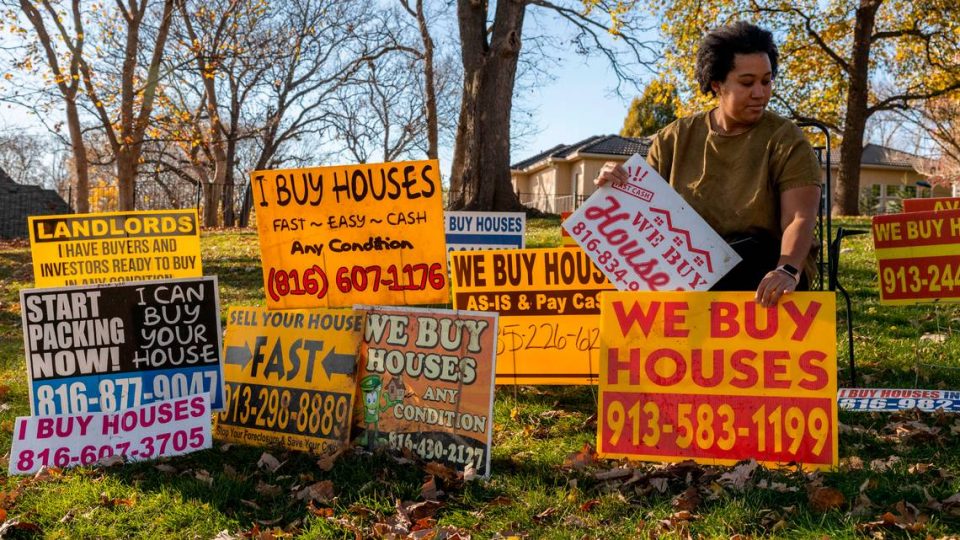Erin Royals started collecting “we buy houses” signs in the summer of 2020. “Once I started to notice the signs, I started seeing them everywhere,” she said. “And it really took me aback.”
READ MORE
Kansas City’s East Side land grab
A monthslong Star investigation looks into how a neglected section of the city has become a hunting ground for real estate speculators and why many Black residents feel they are once again being exploited and left behind.
Expand All
For years, Erin Royals was vaguely aware of the bright red, yellow and white signs that said things like “We Buy Ugly Houses” and “Cash for Homes.”
But the posts struck her altogether differently as she began walking her dog on Kansas City’s East Side during the summer of 2020.
“Once I started to notice the signs, I started seeing them everywhere,” she said. “And it really took me aback.”
Royals, a doctoral student studying geography, sees the cash-for-homes industry as a predatory movement that targets the poorest communities, stripping homeowners of their largest piece of wealth.
“Somebody has convinced them this is the only way to deal with debt or other financial trouble,” she said. “It’s like taking advantage of folks who are vulnerable and not giving them the full breadth of information and options.”
To fight back, she’s been collecting those signs, filling up her trunk and amassing a collection of hundreds of signs she stores at her parents’ suburban home.
Royals, along with University of Missouri-Kansas City doctoral student Jordan Ayala, also has been mapping the signs’ locations throughout the city. The researchers were not surprised to find most were concentrated in neighborhoods east of Troost Avenue, the city’s historical racial and wealth dividing line.
“Things do not happen randomly,” Royals said. “Our lived experiences are not random. These signs are not randomly placed. They’re not along Southwest Boulevard. We don’t see them on Ward Parkway.”
The investors posting these signs or sending postcards or text messages aren’t breaking any laws. They’re trying to find increasingly valuable real estate without going to the traditional housing market. While they’re active in nearly every stretch of the metro area, these investors are particularly aggressive on Kansas City’s East Side, where a disproportionate number of homes are owned by investors, not residents.
Selling to a “We Buy Houses” outfit can allow sellers to get cash for a home in a matter of days. That can be desirable for a home with lots of problems or for a far-away seller who might have inherited a home and has no plans of ever inhabiting it.
But prices by design are significantly less than what a seller would receive on the open market. And researchers say that has major implications for communities of color, which collectively have far less wealth than their white counterparts.
Some investors are looking to buy houses they can rent out. Others want to take an outdated home and flip it for a quick profit.
Others, like Damon Caldwell, aren’t really looking to buy at all.
Caldwell is what’s known as a wholesaler, a middleman in the world of real estate speculation. As a wholesaler, he buys and sells contracts, not the actual houses.
Here’s how it works: He has to buy at a discount and then, as quickly as possible, resell that contract at a profit to a separate speculator. The speculator may then choose to fix and flip that property yet again for another profit, or rent it out as a longer-term investment.
To find potential real estate deals, Caldwell slowly cruises block after block in Kansas City looking for houses in disrepair, that are empty or those burdened by tax liens that make them vulnerable to sale on the courthouse steps.
He’s aided by a $50-a-month app that pulls public data on every property he passes, showing its owner, listing and sales data from the Multiple Listing Service, the database used to manage traditional real estate transactions.
Caldwell will knock on doors of occupied homes that pique his interest. He’ll also search out adult children or even grandchildren who might have been left an empty house in the old neighborhood they no longer live in.
“I don’t see it as taking advantage at all,” said the 33-year-old Caldwell. “I look at myself as a problem solver. If I sell it to someone who’s going to make that house better, it’s helping that neighborhood. I’ve been in houses where the house next door is an eyesore. No one wants to look at that all the time.”
In 2017, Caldwell put his first house under contract at a sale price of $21,000. He then quickly resold the contract for the house in Vineyard Estates for $23,000, pocketing the $2,000 difference for himself.
Kim Tucker said there are bad actors and fair operators in real estate investing, just as in any industry. She’s an investor, Realtor and executive director of the Mid-America Association of Real Estate Investors.
She said investors have an array of tools to find leads. There’s the cold calling and unsolicited postcards. They can buy lists of homes at risk of foreclosure, those with property violations or those with absentee owners.
Tucker said investors traditionally look to spend no more than 70% of what they think a home will be worth. That figure includes the cost of buying and rehabbing a property and usually gives the buyer a 30% cushion for insurance, taxes, commissions and ultimately profit.
“Now that’s down to 20 percent. A lot of investors are working on a really low margin now,” Tucker said.
BEHIND OUR REPORTING
How we did this story
In order to provide a full account of the changes occurring in the neighborhoods on Kansas City’s East Side, The Star launched a months-long investigation that included an examination of a majority of the 208,000 parcels that make up Kansas City’s real estate landscape.
The project started with a central question: Who owns the East Side?
That question sent a team of reporters into the depths of city, county and state documents, multiple data sets, mapping, research reports and, of course, into people’s neighborhoods and lives.
On the East Side and elsewhere, The Star conducted more than 150 interviews with individuals whose time and openness we are grateful to have received and without whose help and candor this series would not be possible.
They include homeowners, renters, real estate agents, landlords, investors, house flippers, wholesalers, contractors, developers, housing advocates, East Side neighborhood groups, politicians, public officials, social scientists. Also of assistance were experts on race and development at institutions that include the University of Alabama, Rutgers University, Tulane University, Bard College, Princeton University, the University of Missouri-Kansas City, the Mid-America Regional Council and Legal Aid of Western Missouri. Read more by clicking the arrow in the upper right.
How did the reporters analyze the property data?
The data mining began using information compiled by the city and made public on the site OpenDataKC. The data allowed The Star to identify by name and/or company the city’s largest real estate owners and to break that list down by the city’s six council districts.
Reporters then created physical maps charting the name and city, state and country of every owner of thousands of parcels in multiple neighborhoods on both the east and west sides of Troost.
Ownership, sales and purchase prices were checked through the Jackson County’s online property and tax records. Agents representing LLCs (limited liability companies) were identified through the office of the Missouri Secretary of State. Eviction cases were checked through Jackson County Circuit Court.
U.S. Census data was used to chart changes in rental rates and area racial makeup over time.
OpenDataKC was used to identify parcels held by The Land Bank of Kansas City. Other documents related to the internal workings of the organization were obtained through Missouri Sunshine Law requests.
On Kansas City’s East Side, many investors look to buy turnkey properties to turn into rentals or fixer uppers they can renovate and rent out. There are also flippers who own the home only during renovations. Most commonly those investors are fixing up homes in poor condition and turning them over to larger corporations that own hundreds or thousands of rental properties.
“For the most part, if somebody’s flipping a house on the East Side, they’re mostly flipping it to an out-of-state or out-of-country investor,” she said. “At one time, our biggest buyers were from Australia.”
While Caldwell doesn’t view his work as predatory, he understands the wider implications of it.
Raised on the East Side, he views home ownership as a path to generational wealth. His father and stepmother have lived in their Vineyard Estates home throughout his childhood.
His advice to them is unwavering.
“Don’t sell it,” he said of their home. “When their time comes, of course it’s going to be left to us. And when our time comes, it’s going to be left to our children. It’s something we can build on. We’re leaving an inheritance to our children.”



